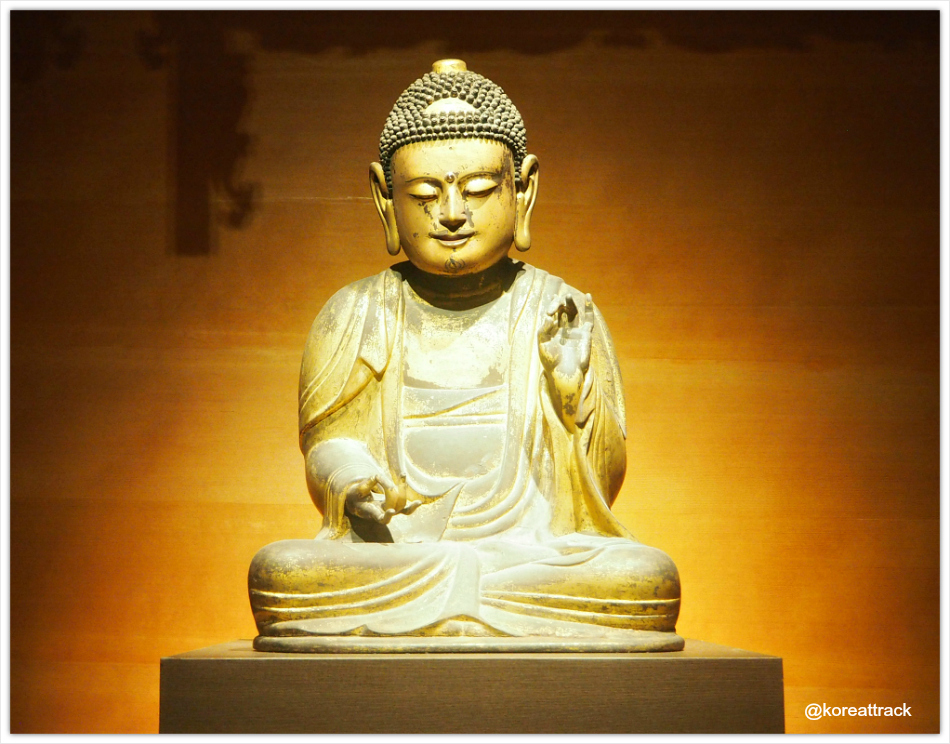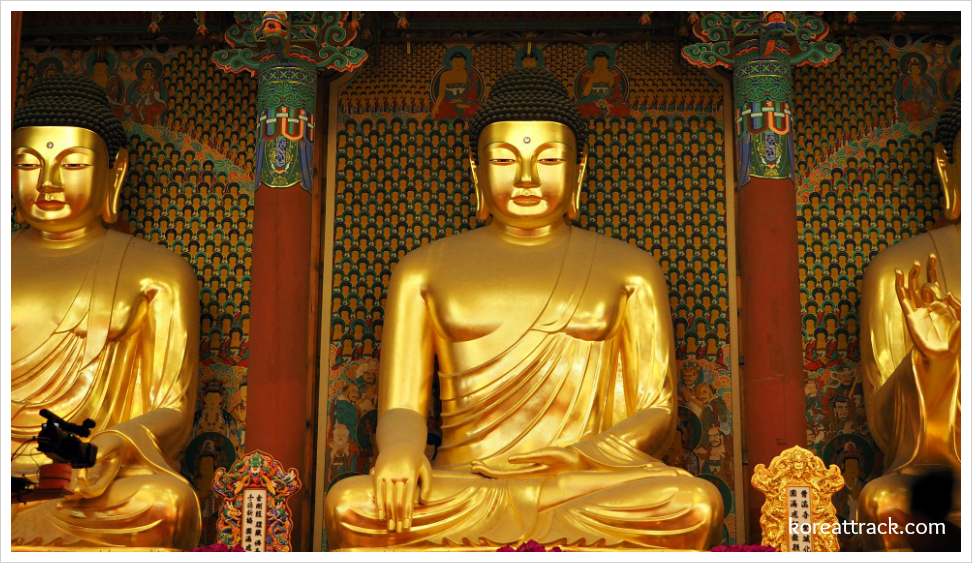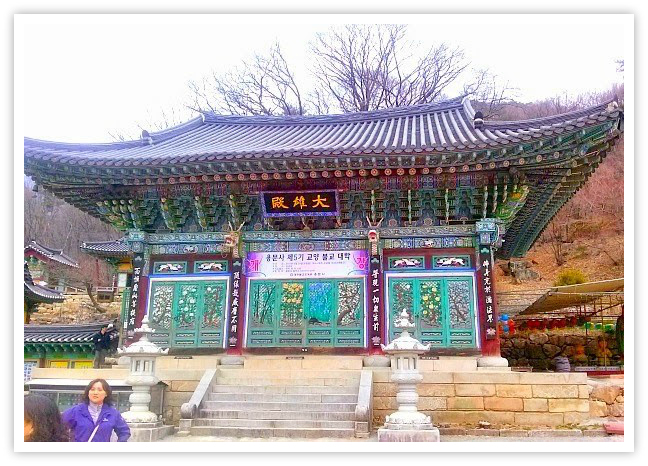Hwaeomsa Temple in Gurye
 A view of Hwaeomsa Temple in Gurye in the Spring.
A view of Hwaeomsa Temple in Gurye in the Spring.Hwaeomsa Temple (Korean: 화엄사; Hanja: 華嚴寺) in Gurye, also known as the Flower Garland Temple, is a head temple of the Jogye Order of Korean Buddhism.
It is nestled on the slopes of Jirisan, Masan-myeon, Gurye County, and South Jeolla Province, South Korea. Here are the fascinating details about this serene temple...
Founding and History
 Hwaeomsa Temple area and its stone lamp and pagoda.
Hwaeomsa Temple area and its stone lamp and pagoda.Hwaeomsa is a renowned Buddhist temple in South Korea. It was established in 544 CE by Venerable Yeongi Josa. Several significant events have shaped the temple's current form.
In 643 CE, Venerable Jajang Yulsa expanded the temple during the Silla era, adding the Sakyamuni Relic Pagoda, a Seven-Story Pagoda, and a stone lantern. These additions transformed the temple into a grand and magnificent structure.
During King Munmu's reign, Venerable Uisang Daesa inscribed the Eighty-Fascicle Avataṃsaka Sutra on stone tablets and preserved them at Hwaeomsa.
This valuable collection of scriptures has been an essential part of the temple's attractions and has helped attract numerous scholars and religious enthusiasts.
 Hwaeomsa Temple's Bell Pavilion
Hwaeomsa Temple's Bell PavilionIn 875 CE, Venerable Doseon Guksa further expanded the temple during the Unified Silla period.
He added several halls, including the Daeungjeon Hall, the Geuknakjeon Hall, and the Myeongbujeon Hall, among others. The temple's transformation during this period marked a significant milestone in its history.
During the Goryeo era, Hwaeomsa was the first temple to undergo renovation as part of a state initiative to transform sites with unfavorable geomantic energy.
The temple was regarded as a site of great spiritual significance and was believed to have been built on one of the eight ideal geomantic locations. This initiative resulted in the temple's further expansion and beautification, cementing its position as one of the most important Buddhist sites in South Korea.
 Hwaeomsa Temple 5-storey Stone Pagoda
Hwaeomsa Temple 5-storey Stone PagodaHwaeomsa Temple in Gurye, South Korea, has a rich history dating back to the Silla Dynasty.
Despite being destroyed during the Japanese invasion in 1593, the temple still preserves some of Venerable Uisang Daesa's inscribed sutras, which many Buddhist scholars and practitioners highly value.
Reconstruction & Preservation
In the 17th century, Venerable Byeogam Gakseong reconstructed some of the buildings destroyed during the invasion.
The Main Buddha Hall (Daeungjeon), the central hall of the temple and home to the main Buddha statue, was also reconstructed between 1630 and 1636.
Further restoration works were done in 1701 during the reign of King Sukjong, which saw the completion of the temple's reconstruction. It was designated as the great temple of combined doctrine and meditation, a title that reflects the temple's significance in practicing Buddhism in South Korea.
Today, Hwaeomsa remains an important center for Buddhist practice and cultural heritage preservation.
Cultural Treasure
As you explore Hwaeomsa Temple, you may come across the magnificent Gakhwangjeon Hall, a stunning structure that is designated as National Treasure No. 67.
Despite its age - having been built during the Joseon era - this awe-inspiring hall is one of the largest buildings in the country, rivaling even the grandeur of the palace building Geunjeongjeon.
As you walk towards Gakhwangjeon, you will be greeted by the sight of a colossal Stone Lantern (National Treasure No. 12), which stands tall and proud, having been sculpted during the United Silla era.
Admire its impressive stature, as it towers over you at a height of 6.4 meters (21 feet) and has a diameter of 2.8 meters (9 feet). The intricate details of this ancient lantern will transport you back in time to an era of skilled craftsmanship and artistic beauty.
Hwaeomsa Temple remains a place of spiritual practice, historical significance, and natural beauty. Its harmonious blend of Buddhism and Korean tradition invites visitors to explore its ancient halls and find peace amidst the mountains. 🌸🏯🙏.
Getting to Hwaeomsa Temple in Gurye County
To reach Hwaeomsa Temple in Gurye from Seoul, you have several transportation options available.
Train and Taxi (Recommended):
- Take the train from Seoul Station to Iksan Station (KTX Seoul).
- From Iksan Station, take the train to Guryegu Station (ITX-Saemaeul).
- Then, take a taxi from Guryegu Station to Hwaeomsa Temple.
- The total travel time is approximately 3 hours and 32 minutes.
Bus via Jeonju:
- Take the bus from Seoul Central City Bus Terminal to Jeonju.
- From Jeonju, take another bus to Gurye.
- Finally, take a local bus or taxi to Hwaeomsa Temple.
- This option takes around 6 hours and 50 minutes.
Driving:
- If you prefer to drive, take your car from Seoul to Hwaeomsa Temple.
- The driving distance is approximately 295.9 kilometers, which will take about 3 hours and 10 minutes.
Fly and Taxi:
- You can fly from Seoul Gimpo Airport (GMP) to either Yosu (RSU), Jinju (HIN), or Gwangju (KWJ).
- From the airport, take a taxi to Hwaeomsa Temple.
- Flight durations vary, but the total travel time will be around 3 to 6 hours, depending on the flight and taxi ride.
Remember to check the schedules and availability of transportation options based on your preferred travel time. Enjoy your visit to this beautiful temple! 🌸🏯🚆
Sources:
https://en.wikipedia.org/wiki/Hwaeomsa
https://bing.com/search?q=Hwaeomsa+Temple+Gurye+South+Korea
https://www.hwaeomsa.org/
https://koreajoongangdaily.joins.com/2014/11/09/koreanHeritage/Gakhwangjeon-Hall-of-Hwaeomsa-Temple-Gurye/2997088.html
https://koreabridge.net/post/hwaeomsa-temple-%e2%80%93-%ed%99%94%ec%97%84%ec%82%ac-gurye-jeollanam-do-dostoevsky2181
- Home
- Temples in South Korea
- Hwaeomsa Temple In Gurye
Get Exciting Activities
Book one of our exciting activities today to experience the thrill of a lifetime! Take advantage of this opportunity and secure your spot in advance.
Hotel Map Guide
Find your affordable, accessible, and comfortable hotel in Seoul at Agoda.Com. See the hotel map below...
Hotel Booking Guide
Find affordable and amazing hotels on Agoda.com using the search box below. Book now to enjoy great discounts and save!







New! Comments
What do you think about this page? Leave me a comment in the box below.